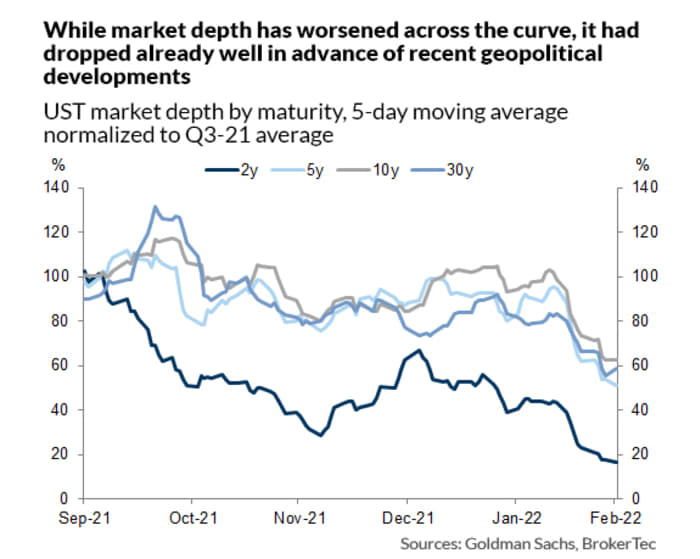This post was originally published on this site
Signs of stress are emerging in the ordinarily well-functioning U.S. rates market, worsening as the Russia-Ukraine conflict rages on.
That stress is reflected in various measures of liquidity and market depth, along with the price impact of order flows and yield dispersion — all of which “indicate a more impaired market,” Goldman Sachs Group Inc.
GS,
strategists Praveen Korapaty, William Marshall and Avisha Thakkar wrote in a note Tuesday. Though the indicators have worsened over the past week, the deterioration isn’t entirely driven by geopolitical events, they said. Instead, the trend has also coincided with the Federal Reserve’s winding down of asset purchases.
Investors depend heavily on the U.S. rates market, particularly the $23 trillion Treasurys sector, to function healthily. Ordinarily, the Treasury market is the deepest, most liquid fixed-income market in the world, so fissures in its functioning can spill over into the rest of the financial system. Signs of trouble were evident toward the end of last year, when BofA strategists pointed to large moves on very low volumes of Treasury inflation-protected securities as a sign that the rates market was unsettled.
Rates market liquidity “has become somewhat thinner” during the wind-down of Fed asset purchases, and “recent developments have merely amplified these strains,” the Goldman strategists wrote. They said one side effect of the Fed’s absence as a “backstop” buyer is “that there is greater risk of market fragility when shocks do arise.”
A chart compiled by Goldman Sachs shows that market depth has worsened across the board, and had already started declining before the Russia-Ukraine conflict. Market depth refers to the market’s ability to absorb large orders without significantly impacting prices. Depth, along with price impact metrics, are now “closer to levels last seen in the midst of the Covid shock, suggesting fairly high risk of disorderly price action.”

Goldman Sachs, BrokerTec
Meanwhile, the daily “Liquidity Stress Dashboard” compiled by strategists Alex Roever and Phoebe White of JP Morgan Chase & Co.
JPM,
showed that four out of roughly two dozen indicators being monitored were flashing “red” as of Monday. Eight of the gauges were marked as “amber,” while the rest were described as “normal.”
On Tuesday, an aggressive rally in bonds continued unabated, with Treasury yields falling across the board. The 10-year rate
TMUBMUSD10Y,
briefly dropped below 1.7%, one of the lowest levels of the year.


